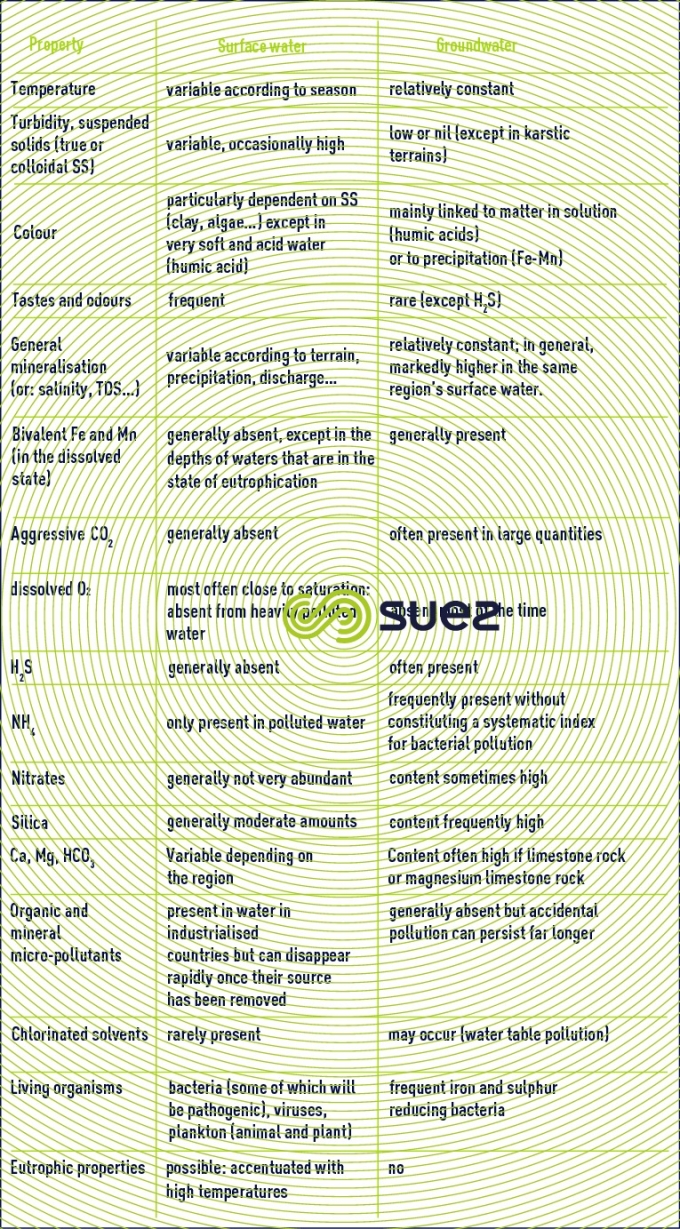surface water
Reading time:This term includes all water circulating or stored on the surface of the continents.
origin
This water comes from either water tables that emerge as springs or from runoff water. This water comes together to form waterways, identified by a noticeable velocity. This water can be stored in natural (lakes) or artificial (reservoir) structures, where a great heterogeneity may appear in terms of water quality depending on the structure’s depth.
general features
Surface water chemical composition will depend on the nature of the terrain crossed by this water. As it meanders, water dissolves the various elements that constitute the terrain. On the other hand, its dissolved gas content (oxygen, nitrogen, carbon dioxide) depends on the exchanges taking place at the water-atmosphere interface and on the metaboilic activity of aquatic organisms found in the water.
Table 1 provides elements that are characteristic of surface water compared with groundwater. We should note the following:
- the presence of dissolved gas, especially oxygen;
- high concentrations of suspended solids, at least for running water. These suspended solids differ very widely, ranging from colloidal particles to detectable elements carried away by rivers when their flow rate increases significantly. In reservoir water, contact time results in the coarser elements settling naturally: this characteristic produces a low, colloidal residual turbidity;
- the presence of organic matter from natural sources created by the metabolism followed by the postmortem decay of plant or animal life living on the surface of the catchment basin or in the river;
- the presence of plankton : surface water can host a major development of phytoplankton (algae …) and zooplankton, especially when eutrophication occurs (please refer to pollution and eutrophication). Some of these organisms can excrete palatable and odorous products or toxins;
- daily (temperature differences, sunshine levels) or seasonal variations, climactic (temperature, rainfall, thawing snow) and plant (leaf fall) variations. These variations can be extremely random: sudden downfalls, storms, accidental pollution.
In surface water impounding reservoirs, water quality will vary from the surface down to the floor of the reservoir (temperature, pH, O2, Fe, Mn, oxidability, plankton). The profile of these parameters itself will vary depending on the periods during which the water levels stratify or circulate according to the seasons.



surface water potability
Surface water is rarely potable without being processed. In addition to the elements quoted, surface water will always be more or less polluted by various discharges:
- of urban origins: discharges created when collecting UWW, even when this wastewater has been processed through a water treatment plant;
- of industrial origins: pollutants and micro-organic (hydrocarbons, solvents, synthesis products, phenols) or inorganic (heavy metal, ammonia, toxic products) pollutants,
- of agricultural origins: fertilisers and other pesticides (herbicides, insectides, fungicides) carried away by rain and runoff water; in intensive cattle farming areas, discharges that are heavily laden with nitrogen and phosphorous and with organic pollution;
- bacterial pollution of human and animal origins.
Bookmark tool
Click on the bookmark tool, highlight the last read paragraph to continue your reading later












